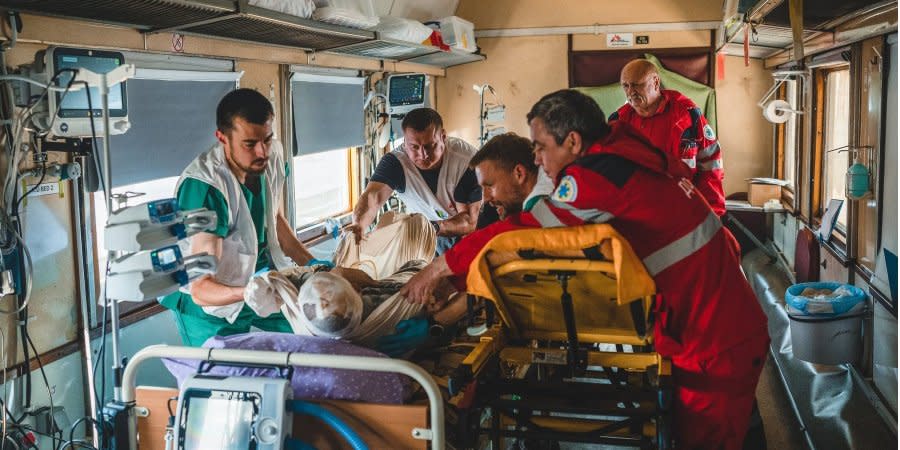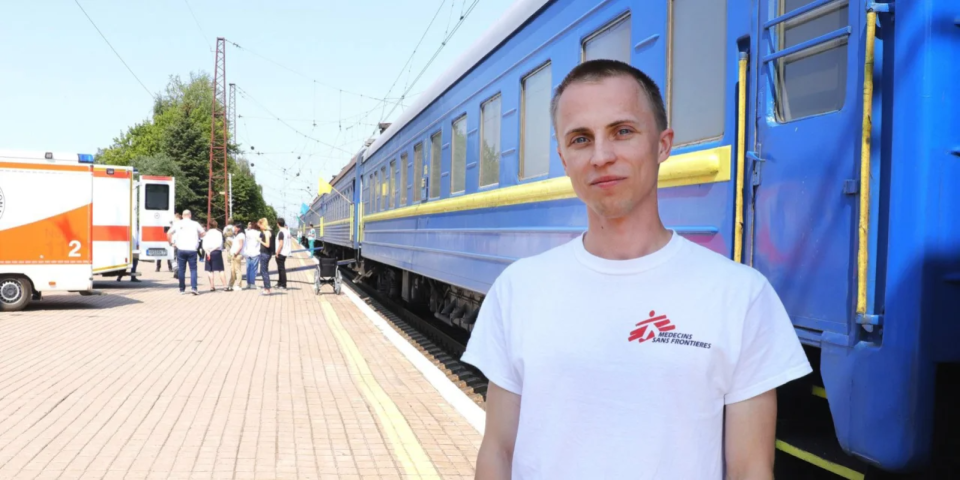Anesthesiologist shares experience of working in Donbas amid hostilities

For many days in a row, the authorities of Donetsk Oblast have been calling on civilians to leave the region, which is constantly bombarded by Russians and has become the scene of the most brutal battles of the full-scale war.
Read also: Reintegration Ministry reports on first week of compulsory evacuation from Donbas
But many locals still remain here, hoping either for an end to the shelling, or for the Ukrainian army – or for a miracle.
Over the past week, the number of wounded civilians in Donbas has increased dramatically. The doctors who work here know this for sure.
The international organization Doctors Without Borders/Médecins Sans Frontières (MSF) has sent eight ambulances to Donetsk Oblast to transport patients from hospitals near the front line to safer places. Also, MSF doctors help the district hospital in Kostyantynivka, Donetsk Oblast, to provide assistance to the wounded and perform operations.
The New Voice of Ukraine spoke with 26-year-old Maksym Zharikov, an anesthesiologist from Kharkiv who now works in Kostyantynivka, about what doctors in the east face on a daily basis, what wounds and injuries civilians get and what strikes medics the most.

NV presents the doctor’s story from his perspective.
We see how civilians are suffering
When the full-scale invasion began, I was at home in Kharkiv, sleeping. Suddenly I heard explosions. Probably the first time in my life I heard them so many in a row. I did not want to believe that the explosions were caused by weapons and artillery.
Mentally, I was ready for the fact that the war would soon start: my car was filled with fuel, my belongings had been packed for several weeks. But anyway, I didn't leave the city for relatively long until a big bomb fell afew hundred meters from my house. Because of my family and because ofmy dog, I decided that it was time to leave the city. We went with our family from Kharkiv, at first we lived with relatives in a village in the center of Ukraine. Then we moved to Dnipro, where I found Doctors Without Borders.
I first went to the east as a translator (for Doctors Without Borders). My English isn’t perfect, but it’s pretty good – and with a medical focus – which is very important for a medical organization.
Doctors Without Borders have long been working in countries where there are armed conflicts and wars. But in Ukraine, the war began in a completely unusual way: no one was ready for what would happen literally tomorrow, and it was very difficult to understand medical needs at first.
They started mainly with humanitarian aid — with medicines and equipment, training, and eventually found places where the resources of Doctors Without Borders were in demand. It was then that I was invited as an anesthesiologist to help a foreign surgical team in the operating room in the city of Kostyantynivka, Donetsk Oblast. As the local population gradually leaves, there are gaps in the ability to cover medical needs.
Sometime in May, emergency medical assistance vehicles started working with us. The key need that we saw — and this is what the local authorities asked us to do — was to move people from hospitals close to the front lines, from very dangerous places, to hospitals at least a little distant from the fighting, where they are safer and where there are more doctors, more equipment and more time to treat these people. This system came into being in May and is still working.
Read also: Frontline medic on her work in the very crucible of war
Since the beginning of May, we have transported more than 400 patients by ambulance, and the vast majority of them are wounded and injured as a result of hostilities.
The city of Toretsk was shelled a few days ago. A public transport stop was pounded there: eight dead, four injured, three of them children. The State Emergency Service and some organizations brought them to Kostyantynivka, to the hospital where we work. We help this hospital not only with the operating room, but also with emergency medical care. One of the patients is a 15-year-old girl who, as a result of the explosions, sustained significant injuries to almost her entire body. She is in a very serious condition, all day and all night the doctors in Kostyantynivka tried to stabilize her at least a little. Now our ambulance is taking her to Dnipro,to the regional children's hospital. She is still in a very tough condition, but everyone understands that compared to Kostyantynivka, the Dnipro regional hospital has greater possibilities of providing assistance with significantly higher chances of recovery. We have many such patients.
About a third of patients require social transportation: elderly or disabled people who need less urgent medical care than getting to a safer place. The road to the safe regions of Ukraine was quite long. A person who had not left the house for several years, has been bedridden, of course, cannot be sure that he can withstand even three to five hours of travel. That's why we help with these transportations.
But the majority of patients are civilians who were injured as a result of hostilities. These injuries vary greatly: from small injuries and psychological traumas to super complex injuries to all parts of the body.
Read also: Military paramedic Yulia 'Taira' Paevska tells NV about three months in Russian captivity
The medical system even in Donetsk Oblast works quite well. Almost all hospitals have doctors left who are willing to provide care, even if it is one surgeon for the entire hospital. In Kostyantynivka, we have our own surgical team, which helps local doctors to perform both surgical and trauma operations.
Yesterday, for example, there was a woman with an open brain injury. There are patients with leg, femur, and tibia fractures. Many lesions of the abdominal cavity and chest require quick surgical manipulation to remove shrapnel and stop bleeding.
In the last week, the number of wounded people who come both to the hospital where we work and to the hospital that asks for our help with the transportation of patients has skyrocketed.
The most morally difficult case was the shelling of Chasiv Yar, around mid-June. This is not the case when the building was struck, but when the bank of the local reservoir was shelled. There were many beach goers who were swimming and they came under fire, 13 people were wounded. Eight of them got to our hospital in Kostyantynivka. All eight are children and teenagers, aged six to 18. Fortunately, they were not seriously injured, although some had broken femurs and other fractures. These eight children will recover within a few months, everything will heal. But it is psychologically difficult to see so many wounded children at once, who should have lived a peaceful life and never felt this way. And there is an understanding that we might never have seen these children alive again.
One of the most difficult cases was a man we operated on who had to have both legs amputated and did not survive. He had lost a lot of blood, the injuries he received during the shelling were not compatible with life, and the fact that he survived even a few hours is a miracle. In fact, he is not the only one.
Predominantly, explosive injuries cause either immediate lethal damage or extensive damage to internal organs. If a person is healthy, he can still survive, but elderly people with chronic injuries cannot withstand such injuries.
Read also: Ex-MP describes what it's like to be a medic on the front lines
Damage from explosions or a blast wave is when a person is struck by vibration, falls down, and is hit again. There are injuries from fragments and splinters that disperse. Firstly, they are hot and cause burns. Secondly, they fly very quickly and enter the organs very rapidly. In such cases, everything depends on the size. If the fragment is the size of a fist, then it leads to death, and if it is small particles, then they cause multiple deep wounds.
Despite the fact that there is international humanitarian law that prohibits the use of certain types of weapons, especially against civilians, we see them being used.
Somewhere in the depths of my soul, I am also afraid, but my conscience says that there is benefit from my work. In addition, I already have some experience of living in wartime conditions. We are relatively in the rear, while the front is several dozen kilometers from the places where we work. This is a false – of course, but still – some sense of safety. But our ambulances work closer to the front line and places that are much hotter.
Read the original article on The New Voice of Ukraine

